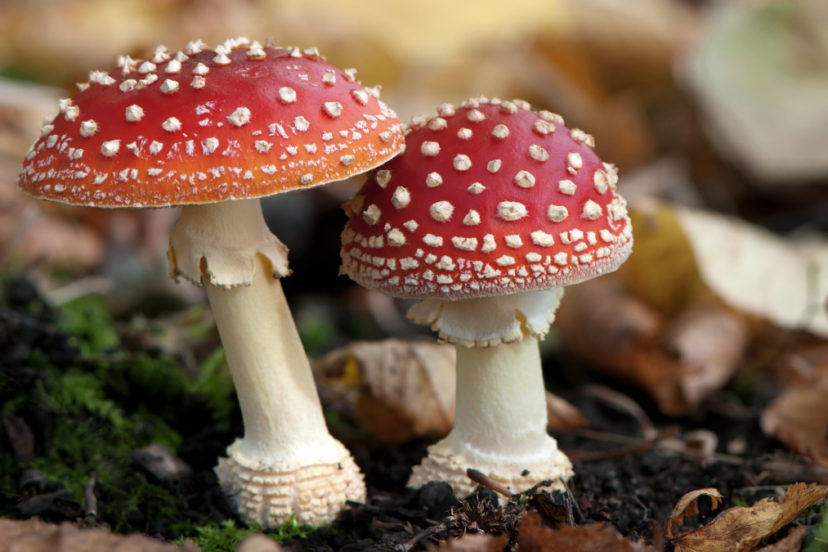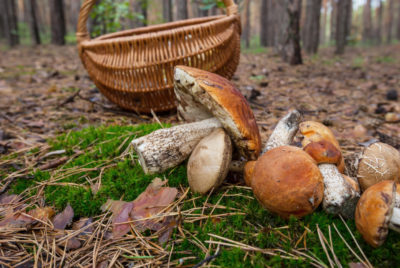One of the best things about mushroom – other than their great taste, of course –…
The Most Common Types of Poisonous Mushrooms

Many types of mushrooms make a healthy and delicious addition to a meal. Some even have medicinal properties.
Unfortunately, there are also plenty of mushrooms that are poisonous. And what’s worse is that many of them look an awful lot like their edible counterparts.
So, as fun and satisfying as mushroom hunting is, you do need to be careful. Having a solid understanding of which mushrooms to pick and which to stay clear of is a very good thing indeed.
With that in mind, here are a few of the most common poisonous mushrooms you may run into on your next outing.
Death Cap (Amanita Phalloides)
Eating a death cap is as bad as it sounds (though they do supposedly taste good). Just a few bites are all it can take to kill you. And you won’t know what’s coming right away either.
Symptoms don’t typically show up for at least a day or two after eating it. And by the time they do, the mushroom has already started doing significant damage do your body.
Death cap mushrooms look innocent enough. They have a round silver cap supported by a pure white stem and grow close to the ground, partially hidden under shrubs and bushes.
They also don’t have the bitter taste that the vast majority of poisonous mushrooms have.
What makes death caps especially deadly is that they often grow where we live – in urban environments. It wasn’t that long ago that a death cap outbreak in Vancouver, Canada claimed the life of a child.
You should, obviously, stay away from all poisonous mushrooms, but death caps are ones you should particularly be careful of.
Destroying Angel (Amanita Bisporigera)
A relative of death caps, destroying angel mushrooms are almost as deadly.
And, like death caps, destroying angels are also fairly innocent in appearance. With a bulging white cap supported by a thick stem, they look more like puffball mushrooms than anything you should be afraid of.
The difference between the two is that destroying angels have gills that are not connected with the stem. The base of their stem also features a broken membrane.
Destroying angels have the somber honor of accounting for the majority of deaths caused by poisonous mushrooms.
The reason for this statistic is that their poison is quite challenging to treat. Symptoms show up five hours or so after ingestion, and, by that time, irreversible damage to the kidneys and liver has usually already been done.
False Morels (Multiple Species)
The odds are that if you like mushrooms, you like morels. Come springtime, this delicacy can be found growing in cooler climates cozying up to dead trees. Unfortunately, so can false morels.
False morels are a broader category that includes multiple species of poisonous mushrooms that can be easily mistaken for morels.
The good news is false morels are not nearly as fatal as death caps or destroying angels. In fact, it’s not unheard of to find people picking and preparing these imposters just like the real thing.
The issue is that different species of false morels have different concentrations of poison. To what degree the poison affects a person can also vary.
So, while some of us may indeed feel perfectly fine after eating a false morel, others could quickly develop symptoms. Those symptoms can include vomiting and diarrhea and, ultimately, may even result in death.
The bottom line is to stick to cooking and eating the real thing. Morels are hollow inside. False morels are not.
Jack O’Lantern (Omphalotus Olearius)
The poisonous Jack O’Lantern mushrooms get their name from their distinctive orange color. They are very similar in appearance to the edible and super delicious chanterelles.
While few people die from eating Jack O’Lanterns, it’s still very much worth staying away from them. Poison is, after all, poison.
The differentiating factor between Jack O’Lanterns and chanterelles is that the former tend to grow in clusters.
A Jack O’Lantern mushroom also has gills, whereas a chanterelle only gill-like structures. And, as one final check, the gills of the Jack O’Lantern glow in the dark. Those of chanterelles do not.
Final Words
Understanding the differences between poisonous mushrooms and edible ones can, literally, mean the difference between life and death. But, as scary as that statement may sound, don’t let it put you off.
Foraging is a very safe activity. As long as you do a bit of research before you go off mushroom hunting – or pack a good guide – you’ll be fine. And, if you ever have any doubts about a mushroom, simply move on.



